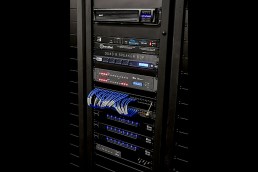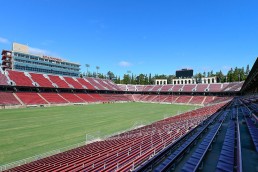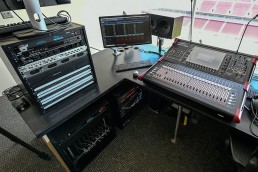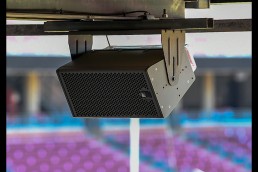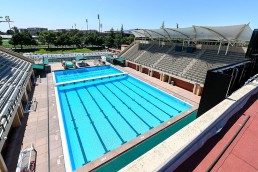This website uses cookies so that we can provide you with the best user experience possible. Cookie information is stored in your browser and performs functions such as recognising you when you return to our website and helping our team to understand which sections of the website you find most interesting and useful.
EMEA & APAC AWARDS • THE AMERICAS AWARDS
Stanford Stadium
ProjectStanford StadiumLocationCalifornia, USAManufacturersMeyer Sound, DiGiCo, BSS InstallerDiversified, Stanford University Submitted byMeyer Sound
Located in California’s Bay Area, Stanford University (Stanford) is one of the world’s leading research universities. The legacy of its founders, Jane and Leland Stanford, and its relationship to Silicon Valley make the educational institution well known for entrepreneurial character. After being established in 1885, and opening in 1891, today, Stanford is home to seven different schools – Business, Earth, Energy and Environmental Sciences, Education, Engineering, Humanities and Sciences, Law and Medicine – more than 16,000 students, 2,100 faculty and 1,800 postdoctoral scholars.
In addition to the leading scholar courses, Stanford is considered an athletics powerhouse boasting 36 varsity sports, 32 club sports and state-of-the-art recreational facilities and fitness programmes. And it’s some of these sporting venues that have received an audio upgrade in recent months to ensure the school remains at the top of its game. With more than 20 different venues, it’ll come as no surprise that the upgrade is taking place in stages. The first three in line for the renovation treatment were Stanford Stadium used for football matches, the Boyd and Jill Smith Family Stadium, which hosts softball and the Avery Aquatic Center.
The original Stanford Stadium was built in 1921 with a seating capacity of 85,000, but when the new dual-deck stadium was built in 2005 – completed in 2006 – a decision was made to decrease the capacity to 50,000 to create an intimate atmosphere during matches – a more up-close fan experience. Furthermore, as the sporting campus grew, extra space was needed to erect other buildings to cater for the expanding sports teams. The stadium has been host to a number of Olympic tournament games and World Cup games in its time, as well as the Super Bowl back in 1985.
With the old PA having been in place since the new stadium was completed, it was time to upgrade, the offerings from audio have significantly changed over the years, as well as the requirements of the PA. Most sporting venues are now not only used for sporting events, but also music concerts, so many such facilities look for a flexible and powerful audio system, nowadays.
Stanford Stadium – home to PAC-12 Cardinal football – was designed, engineered and installed by Diversified, a global technology solution provider. Meyer Sound Design Services collaborated during the design phase, with prominent sports venue consulting firm, WJHW providing oversight and guidance on the football stadium. The in-house tech team at Stanford also assisted with the installation to ensure a smooth project delivery.
Assistant Athletics Director of Technical Operations at Stanford, Mackenzie Haynes said: “My knowledge of the venues and technical insight of professional audio gave me the experience to take on this project. While the Stanford Stadium project was vast, my experience in the industry was the crux between project management and technology that was needed to execute this.”
The brief for the new PA was that it must be aesthetically pleasing, as well as offer consistent and intelligible sound for each visitor at any sporting event. “We discussed multiple design options with our consultant, WJHW. With a limited budget, we needed to make sure we could get the best product for our stadium,” Mackenzie continued. “At one point, we discussed a point source solution from one of our videoboards. But, after stepping back to focus on the end-user experience we talked through a design that was the best solution instead of focussing on cost. From that point, we found that utilising the existing infrastructure could give us enough locations to create a seamless listening experience for each of our fans.”
With a clear brief in mind, the design team decided to rethink what was possible using the newest digital beam-shaping technology as incorporated in Meyer Sound’s self-powered column array loudspeakers. A total of 80 column array loudspeakers were installed at the stadium, using all three models in the series: the 10ft high CAL 96 – with 96 individually processed and amplified loudspeakers – as well as the smaller CAL 64 and CAL 32 models.
“The beam steering technology lets you put a loudspeaker in what otherwise wouldn’t be an optimal vertical location,” said Peter O’Neil, Director of Engineering at Diversified. “Horizontally it needs to be set in the right place, but in the vertical dimension you can use the beam steering to successfully cover the seating plane in a way often not otherwise possible.”
The extraordinary pattern control avoids problems often encountered in large stadium sound systems, explained WJHW Associate Principal Mark Graham. “One problem with distributed systems, when using long throw loudspeakers, is that if you don’t have the vertical control of the Meyer Sound column arrays, you can have sound from one side of the stadium leaking over to the other side. And if it’s loud enough it will degrade intelligibility of the spoken word. But with the CALs and their narrow vertical pattern we can pretty much dictate exactly which seating areas each loudspeaker will cover and prevent that problem.”
Mark also noted how the slender profile of the column loudspeakers enables discreet coverage of problem areas of upper decks between lighting structures. “With conventional solutions crossfiring into those areas you can have horrible problems with time arrivals. But with these column arrays, we simply add a small pole, which is fairly inexpensive and unobtrusive architecturally, and you can steer sound right down into that area.”
Although presenting a slender profile, the column array loudspeakers have ample power to punch through crowd excitement, according to Meyer Sound Director of Business Development, John Monitto. “Besides distributing the sound in an even, well-controlled manner, the CALs also give you very high peak output to deliver excellent intelligibility over crowd noise, even at high points of the game.”
To cover seating areas where a column array solution was not appropriate, Stanford Stadium system also incorporated 84 UPJunior and 10 UP-4XP loudspeakers.
Mackenzie is extremely pleased with the end result of the Meyer Sound CAL system. He highlighted the ability to steer each beam of sound, so that the audio can focus on the exact seating area in front of each loudspeaker, as one of the reasons for selecting the CALs for this project. The fact that all Meyer Sound loudspeakers are active and powered was also a huge benefit because it reduced the previous rack space footprint from 21 full sized racks to just six racks.
For processing a series of BSS Soundweb London BLU-160 DSPs are used for minor processing and distribution throughout the stadium. After each BLU-160, the signal is distributed into a Meyer Galaxy 816 processor that is on the closed audio network and can be monitored during all games. For mixing requirement, an upgrade also took place, with the stadium moving from an analogue to a digital console – a DiGiCo SD9 with the D2 Rack was selected. Mackenzie continued: “The customisation of a digital console is something that was very much overdue for this venue. Additionally, the simplicity of use from the DiGiCo has been a great addition for our A1 on game days.”
Broadcasting from the stadium is also easy and straightforward with the truck dock being capable of handling two or three 53ft OB trucks with an uplink. The stadium is fitted with triax, fibre, and audio connections in dozens of locations throughout the stadium, which all run back to the truck dock I/O.
Despite the sophisticated digital technology, Diversified’s Peter is fully confident in the new system’s long-term reliability. “It’s a proven solution,” he noted. “With a working base in other outdoor stadiums, including Memorial Stadium in Berkeley, which has been in use for several years. It holds up to the elements, and it also holds up to football games where you need the horsepower.”Next up for an audio renovation was the Avery Aquatic Center, here, two Meyer Sound CAL 96 loudspeakers and one CAL 64 loudspeaker centred above the scoreboard provide an elegant point source solution for grandstand seating accommodating up to 2,480 spectators.
“This was an interesting challenge because it’s an open facility with other pools around it, with practices scheduled at the same time as events,” continued John. “They don’t want to be disturbed by what’s happening in the competition arena. So here CAL was a great point source solution, targeting a majority of the audience with only a minimum number of outfill loudspeakers needed.”
The fill systems comprise nine Meyer Sound MM-4XP and two UPJ-1XP loudspeakers. For events – such as synchronised swimming – that require high fidelity, full-bandwidth music, the system provides controlled deep bass through three 750-LFC low frequency control elements deployed in a cardioid configuration.
For the softball Boyd and Jill Smith Family Stadium, which features a scalable capacity from 1,500 up to 3,500, the new Meyer Sound system includes two CAL 64 column array loudspeakers along with four UPJunior-XP loudspeakers. Mackenzie furthered: “I worked directly with Meyer Sound and discussed the simplest and most efficient use of the seating areas. After visualising options using EASE modelling, we found the ideal locations for each loudspeaker. Once we had that, I worked with an electrical and installation group for cable pathway and specifications to ensure the system as a whole would function as needed.”
“Another great thing about a CAL solution is you have flexibility to deal with scalable seating scenarios,” added John. “If you need to redistribute the sound, you can simply program another preset to steer it into a tighter or broader coverage pattern to fit the new seating configuration.”
Another factor favouring a comprehensive Meyer Sound solution, John furthered, was proven product longevity. “Several of the outdoor facilities here had installed MSL-3 systems more than 25 years ago and they are still working well. It shows what we put into weather protection research back then, and we continue to evolve that technology to further extend the life of products with exposure to the elements.”
Future phases of the facility upgrading programme are set to include new Meyer Sound systems for Laird Q. Cagan Stadium at Maloney Field that will be used for soccer and lacrosse, and Klein Field at Sunken Diamond for baseball.

